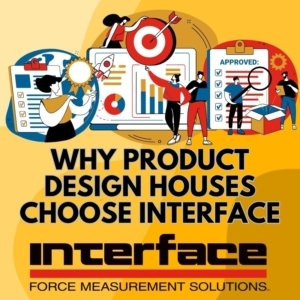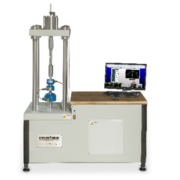Why Product Design Houses Choose Interface
 When people think of force measurement, they often think that it is a tool for testing products. However, load cells, torque transducers and multi-axis sensors also play a fundamental role throughout the entire product design process. In fact, many products today actually design force sensors directly into products.
When people think of force measurement, they often think that it is a tool for testing products. However, load cells, torque transducers and multi-axis sensors also play a fundamental role throughout the entire product design process. In fact, many products today actually design force sensors directly into products.
Product design houses are companies that fulfill outsourced design work for a variety of industries. These specialized design houses are contracted to develop and bring products to life.
A product design house primarily focuses on designing physical products or tangible goods. The services they offer to product makers, engineers, manufacturers, and innovators typically involve the entire product development lifecycle, from conceptualization and design to prototyping and manufacturing.
Due to our experience and expertise across multiple industries, Interface collaborates with product design houses in identifying the right sensors and systems to use during different stages of the design process. Whether it is for accurately measuring forces for impact and fatigue testing, identifying precise weights for packaging, modeling consumer usability, or testing material strength, Interface products are chosen by design houses based on their range of capabilities, accuracy, versatility and quality.
How Product Design Houses Use Interface Products
- Concept Development and Prototyping: Product design houses often use Interface product design files when refining their initial product ideas or creating new concepts. When the products move into physical modeling, Interface products are used for testing and validation at this early stage.
- Industrial Design: Industrial designers use Interface load cells and other sensor products for measuring functionality of the product.
- Design Validation and Testing: Conducting tests and simulations to validate the product’s performance, durability, and safety are the number one reason why design houses utilize Interface measurement solutions. Design houses put sensor technologies into products to provide force data for user feedback, to optimize performance, safeguard consumers and activate components.
- Mechanical Engineering: The mechanical engineering team of a design house will connect with Interface when they are working on the technical phases of product design. Our products are used to help ensure the final product can be fabricated efficiently, performs consistently, and meets applicable safety standards.
- Materials and Manufacturing: Experts at design houses that are versed in materials science and manufacturing processes will consult with Interface in finding measurement solutions that can access and validate material testing and production systems. Within the manufacturing realm, these devices are employed in quality control processes to ensure consistent product standards.
- Packaging: If a product has packaging that must meet durability, temperature, pressure or fatigue requirements, Interface will provide sensors and instrumentation for design testing.
- Regulatory Compliance and Certification Support: For products subject to regulatory standards, design houses utilize high accuracy measurement solutions in creating specifications, reporting, and compliance requirements before moving to market.
These services can vary from one product design house to another, and some design houses may specialize in specific industries or types of products.
Product design houses leverage Interface load cells across various industries to measure and monitor forces and weights with precision. For example, in medical device development, Interface miniature load cells are used for patient lifts, ensuring secure and accurate weight measurements.
Whether used in material testing, robotics, or agricultural machinery, load cells enable product design houses to create innovative solutions tailored to specific industry requirements, enhancing overall product performance and reliability. Here are a few examples of house product designers use force measurement solutions during the design phase.
Furniture Fatigue Cycle Testing
To meet safety protocols in relation to the manufacturing of various furniture products, fatigue testing, shock testing, and proof testing must be rigorously performed before diffusion into the marketplace, and into the homes of consumers. Force testing of furniture products is critical in determining the posted max loads to protect manufacturers from liability due to damage that might result from the misuse of those products and overloading. Using Interface’s SSMF Fatigue Rated S-Type Load Cell along with Interface’s 9890 Strain Gage, Load Cell, & mV/V Indicator provided a solution that measures the force being applied in fatigue cycle testing of a furniture product, in this case, testing the rocking mechanism in an office chair. Throughout the testing phase, changes were made to the design to improve the safety and life of the furniture, ensuring product quality and protecting the manufacturer from future liability.
Self-Checkout Kiosk Functional Testing
To assess the design of self-checkout kiosks, part of the development cycle is to ensure the weighing feature is functioning properly with the right amount of sensitivity when customers want to weigh products like fruits or vegetables. The designers also needed a system that measures the force it takes for the self-checkout kiosk to activate a response for consumers. Interface suggested installing SSB Load Beam Load Cells under the plate where items are weighed. When connected to the WTS-AM-1E Wireless Strain Bridge Transmitter Module, force results are wirelessly transmitted to the WTS-BS-6 Wireless Telemetry Dongle Base Station on the customer’s PC. Data can be logged and graphed with included Log100 software. Interface’s wireless force system successfully measured the amount of force it took for the self-checkout kiosk to react and ensure it is functioning properly.
Design of a Prosthetic Foot
In the design of this medical device, the product designers need to know how the foot responds as it is loaded during different stances. To measure this, Interface’s 3A120 3-Axis Load Cell was installed between the leg socket and the prosthetic foot. The 3A120 was then connected to the BSC4D Multi-Channel Bridge Amplifier and Computer Interface Module. Using this solution, data was logged for X, Y, and Z axis. The design house was able to review the results and identify premature flat foot and dead spots during foot’s production for consumer use. They utilized this vital information to make improvements to the design.
Interface works with design houses and product design engineers across the continuum of a product’s development through go-to-market. We supply standard measurement sensors like our load cells, along with custom solutions that are uniquely engineered for a particular use case.
ADDITIONAL RESOURCES
Why Product Design Engineers Choose Interface
Interface Solutions for Consumer Products
Introducing the Interface Consumer Product Testing Case Study
Interface Mini Load Cells Growing in Product Use and Testing








